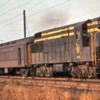As a life long resident of the New York City Metropolitan Area, I'm naturally fond of the railroads and equipment which have operated throughout the region over the years. In fact, I've developed a "bucket list" on which I've included models if ever offered in O scale, I promised myself I would purchase. In recent years, this list has grown smaller thanks to the release of several NYC, PRR and NH electrics, the CNJ AGEIR built 1000 and Raritan River SW900s.
Thankfully, my list decreased yet again this week with the arrival of MTH's Premier Train Master H24-66 decorated for the Central Railroad of New Jersey. The Train Masters were CNJ's primary diesel passenger power, continually hauling seemingly endless strings of coaches filled with commuters to Bay Head Junction, Phillipsburg and intermediate points. MTH has done a credible job in capturing the look of CNJ's units. The green and yellow are accurately reproduced, lettering is sharp, comprehensive and positioned correctly. Even CNJ's road specific class of FPSD-67 is stenciled on the model. Headlight placemement is correct per CNJ practice and the bell is properly positioned at the top of the end of the long hood.
While I'm very pleased at the accuracy of the traits mentioned above, I'd be remiss if I didn't mention the few things I've found which deviate from the CNJ's units. First, CNJ's Train Masters were equipped with a unique two aspect classification lamp at each corner of the unit. One lens faced forward and the second faced sideways. As this was a feature limited to CNJ's units, I would not expect it to be reproduced on a plastic model. The second discrepancy I identified was the inclusion of dynamic brakes. Unlike the great majority of Train Masters which were built with dynamic braking, CNJ's units were built without this feature. Again, since the majority of Train Masters were equipped with dynamics, I can understand why these details are included on the CNJ model.
As far as operation is concerned, I run conventionally. Using my Z-4000 transformer, the locomotive operated smoothly. The sound system features a Fairbanks-Morse prime mover, the bell is clear and the horn is of a multi-chime type. CNJ's units were equipped with single note horns so I may look to change it at some point in the future.
As someone who spent a lot of time around the real CNJ Train Masters, I'm very pleased with this model. As much as I love my Lionel 2321 Lackawanna and 2322 Virginian Train Masters, the MTH Premier model is the finest plastic rendition of the this legendary locomotive I've seen to date.
I'll see what I can do about getting some pictures posted.
Oh, by the way, the bucket list is about to get even shorter when my New Haven FL9 arrives from 3rd Rail in a few weeks! ![]()
Bob






